Event Details:

Stanford Neurosciences Institute Seminar Series Presents
A neural circuit that suppresses appetite in response to peripheral threats
Richard Palmiter, Ph.D
Professor, Department of Biochemistry; Investigator, HHMI; Adjunct Professor, Genome Sciences, University of Washington
Host: Xiaoke Chen
Abstract
Activation of a small population of inhibitory neurons in the arcuate hypothalamus that make agouti-related protein (AgRP), neuropeptide Y (NPY) and GABA promotes feeding behavior while suppressing non-essential behaviors and physiological processes. These neurons are normally activated when energy stores are low, e.g. during starvation. Artificial activation of AgRP neurons using optogenetic or chemogenetic technologies stimulates robust foraging and feeding behaviors by mice in the absence of energy need. AgRP-expressing neurons send axon projections to many brain regions; the molecular identity of the post-synaptic neurons and the circuits that they engage are just beginning to be deciphered. While activation of AgRP-expressing neurons represents a ‘hunger’ signal, excitatory (glutamatergic) neurons that express calcitonin gene-related protein (CGRP) in the parabrachial nucleus encode a ‘satiation’ signal that suppresses food intake when they are activated. These CGRP-expressing neurons are activated by visceral signals produced in response to a large meal, nausea or visceral malaise. Artificial activation of CGRP-expressing neurons by optogenetic or chemogenetic methods inhibits food intake by otherwise hungry mice and their chronic activation of leads to starvation. Ablation of AgRP neurons in adult mice results in starvation due disinhibition of the CGRP neurons, while activation of AgRP neurons in mice without CGRP-neuron function promotes excessive food intake. Thus, there is a functional interaction between ‘hunger’ and ‘satiation’ neurons.